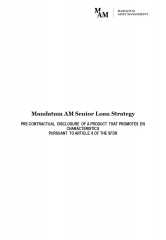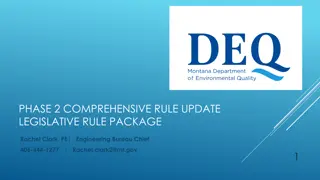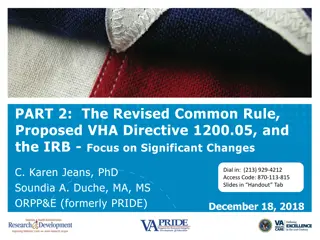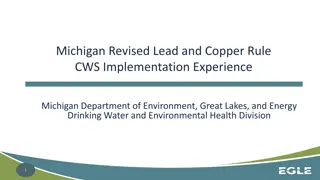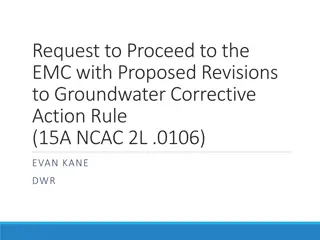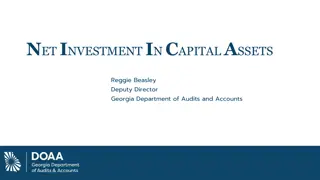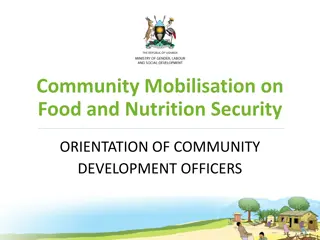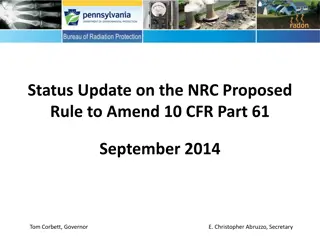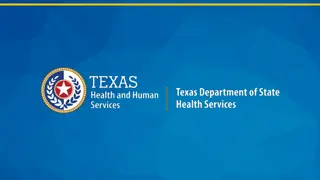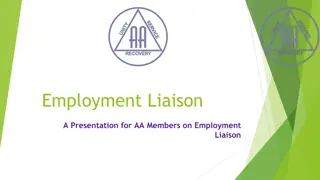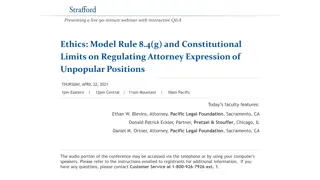Proposed Rule Community Investment Officers Update
The presentation discusses the proposed rule for Community Investment Officers (CIOs) in the context of the Federal Home Loan Banks' Affordable Housing Program (AHP). It highlights the background, requests from CIOs, collaborative processes, and the role of AHP within the housing finance system. The presentation emphasizes the private nature of AHP as a gap funder, distinct from federal funding, with a focus on regional responsiveness and market opportunities. Changes in regulations aim to improve transparency, simplify administration, and enhance the effectiveness of AHP.
Download Presentation

Please find below an Image/Link to download the presentation.
The content on the website is provided AS IS for your information and personal use only. It may not be sold, licensed, or shared on other websites without obtaining consent from the author.If you encounter any issues during the download, it is possible that the publisher has removed the file from their server.
You are allowed to download the files provided on this website for personal or commercial use, subject to the condition that they are used lawfully. All files are the property of their respective owners.
The content on the website is provided AS IS for your information and personal use only. It may not be sold, licensed, or shared on other websites without obtaining consent from the author.
E N D
Presentation Transcript
1 AHP Proposed Rule Community Investment Officers April 27, 2018
Disclaimer This presentation is based on publicly available information as of April 26, 2017. It is the understanding of the CIOs that there may be additional changes to the Proposed Rule subsequent to this presentation.
4 Background In October 2014, the CIOs of the FHLBanks met with the FHFA to request an update to the AHP regulation. The CIOs had 41 recommendations rolled into four high level requests. Expand discretionary authority of FHLBanks to allocate the 10% AHP contribution to meet the needs and strategic objectives of their districts. 1. Simplify administration, ensure consistent application of standards, and increase transparency of the AHP by improving clarity with respect to monitoring and need-for-subsidy determinations. 2.
5 Background (Cont.) The CIOs had 41 recommendations rolled into four high level requests. Coordinate AHP to work with other major funding agencies by eliminating redundant oversight and subordinating AHP requirements where conflicts exist. 3. Improve the FHLBanks ability to resolve noncompliance and to arrive at settlements that are in the Program s best interests by expanding the tool kit of workout options. 4.
6 Collaborative Process Unprecedented collaborative dialogue among the FHFA, FHLBanks, Advisory Council Leadership, and other stakeholders. Opportunity to exchange information about how AHP is applied in the field, and how to optimize AHP s value and position it for future and changing affordable housing needs. CIOs are sympathetic to the challenges the Agency faced Look forward to continued dialogue
7 Overview Sandra Thompson, Deputy Director, asked where AHP fits within the nation s housing finance system: AHP is a private source of gap funding generated by the Members of the Federal Home Loan Bank System It is not federal funding, but private It is designed to be regionally responsive It has a pristine track record As a gap funder that responds to existing market opportunities, definitions and requirements that apply to Duty to Serve and Housing Goals are not applicable to AHP.
8 Key Takeaways Increases complexity and limits the FHLBanks ability to respond to local affordable housing needs. For example, the proposed outcome requirements limit responsiveness and create barriers to enhancing the effectiveness of the Affordable Housing Program. The FHLBanks are a Congressionally established, privately- owned cooperative designed to respond to the regional needs of its membership and affordable housing partners. Ask the Agency to be open and receptive to solutions provided by the FHLBanks, its members and affordable housing partners.
9 Favorable Proposed Changes
10 Favorable Proposed Changes Increased flexibility for allocating funds in the Set Aside program(s). Streamlined monitoring requirements in some circumstances Settlements Expanded definition of home purchase to include rehabilitation
12 Areas of Concern Outcome Requirements Comment Period Ownership Retention Expanded Targeted Community Lending Plan Requirements Need for Subsidy Increased Governance Requirements Scoring Mandatory Funding of Alternates Modifications
13 Outcome Requirements Increases complexity and limits the FHLBanks ability to respond to local affordable housing needs Unduly restricts the FHLBanks autonomy Restricts types of projects that may access Competitive AHP
14 Outcome Requirements (Cont.) Minimum thresholds for Underserved Communities & Populations are excessive Regulatory priorities could trigger re-ranking of applications = increased reputational and legal risk for the FHLBanks and removes clarity around program Regulatory priorities become the de facto scoring methodology and become the de facto district housing needs assessment to ensure outcomes are achieved
15 Outcome Requirements Given dialogue between FHLBanks and the Agency, the FHLBanks seek written clarity around the Outcome Requirements calculation Consideration of Set Aside Program
16 Outcome Requirements (Cont.) Given: Annual Required AHP Contribution = $30 million 30% Set-Aside Allocation = $9 million Statutory priorities is based on Total AHP Funds Allocated to General Fund (GF) and Targeted Fund (TF) Regulatory priorities is based on Required Annual AHP Contribution Statutory Requirements = 55% of Total AHP Funds Allocated Regulatory Requirements = 55% of Annual Required AHP Contribution
17 Outcome Requirements (Cont.) Statutory Priorities Threshold: Calculation Total AHP Funds Allocated to GF/TF = $21 million ($30 million Annual Required AHP Contribution minus $9MM Set-Aside allocation) Statutory Threshold = $11.6 million ($21 million X 55%) Regulatory Priorities Threshold Calculation Annual Required AHP Contribution = $30 million Regulatory Threshold = $16.5 million ($30 million X 55%)
18 Outcome Requirements (Cont.) Set Aside Allocation (in millions) Home Purchase $6 General Fund & Targeted Fund(s) (in millions) Amount Available $24 Required to meet Outcome Requirements $16.5 Required to meet statutory priorities $13.2 20% 80% 69% (of $24) 79% (of $21) 92% (of $18) 55% $9 30% $21 70% $16.5 $11.6 55% $12 40% $18 60% $16.5 $9.9 55%
19 Outcome Requirements (Cont.) The FHFA s contradiction serves to illustrate the complexity of portions of this proposal, particularly as it relates to the outcome requirements. Recommendation: Eliminate the new, complex proposed outcomes structure and revert to a scoring based methodology.
20 Ownership Retention Recommendation: Allow FHLBanks discretion to require retention on homeownership projects as they deem fit. Doing so: Allows for regional differences across the 11 FHLBank Districts Allows FHLBanks to better manage regional differences within their own Districts. For example, the FHLBDM s district includes Missouri, Guam, Alaska and Hawaii Allows FHLBanks to delineate between various grant amounts. For example, under FHLBCincy s set-aside program, grants are limited to $5,000 per household. Under their Competitive AHP grants up to $50,000 per household are permissible
21 Targeted Community Lending Plan (TCLP) Increased housing needs assessments and analysis may be unnecessary given proposed regulatory priorities requirements Housing needs must be included in TCLP in order to count towards outcome requirements Limits ability of Advisory Councils to address emerging needs 6 month and 12 month required lead times limit responsiveness of AHP
22 TCLP (Cont.) The expanded TCLP requirements introduce additional administrative costs to the FHLBanks that seem unnecessary given the regulatory priorities requirements. Recommendation: If the outcomes approach is adopted in the final regulation, the FHLBanks request that the requirements of the TCLP remain unchanged from the existing Community Support Regulation. In this case, the FHLBanks believe that each FHLBanks AHP Implementation Plan sufficiently addresses local housing needs.
23 Need for Subsidy Proposed Regulation requires FHLBanks to consider operating pro forma and reasonableness of cash flow and costs. Preamble notes that FHFA expects the Banks to require a separate supportive services budget that captures income and expenses for all supportive services activities to ensure they can be reasonably offered.
24 Need for Subsidy (Cont.) Requires supportive services to be treated differently than any other ineligible AHP expense, for example, capitalized reserves, furniture and equipment, etc. Requirement acts as an unnecessary obstacle to projects that include supportive services, yet provision of supportive services is required to meet special needs definition under the regulatory priorities.
25 Need for Subsidy (Cont.) On the aforementioned April 11 conference call with FHFA, the FHFA indicated: That despite language in Proposed Rule, FHLBanks will be governed to the standard set in the preamble, which introduces confusion and complexity into the administration of the program; and, Additional regulatory guidance on Need for Subsidy may be forthcoming. Recommendation: FHLBanks reiterate their position that supportive services should not require a separate budget.
26 Need for Subsidy (Cont.) Recommendation: Given the concerns expressed by the FHLBanks and Advisory Councils on numerous occasions, the FHLBanks believe that the Proposed Rule is the appropriate format for implementing Need for Subsidy requirements, not Advisory Bulletins or Regulatory Interpretations.
27 Increased Governance Full Board must meet with Advisory Council CIOs unsure as to why this increased governance requirement is being proposed Poses operational challenges for FHLBanks with large geographic areas, such as FHLBanks Des Moines and Atlanta More appropriate for Division of Bank Regulation than Housing and Mission Goals to determine Board governance requirements. Recommendation: Retain governance requirements in the existing AHP regulation.
28 Scoring In theory, FHLBanks like ability to develop own scoring In reality, the regulatory priorities requirements circumvent proposed FHLBank autonomy by requiring FHLBanks to develop scoring that will ensure compliance with regulatory priorities requirements. Recommendation: Eliminate the new, complex proposed outcomes structure and revert to a scoring based methodology.
29 Alternates Section 1291.26(b) requires the FHLBanks to identify alternates and within one year of approval, must approve such alternates for funding if any previously committed AHP subsidies become available. Alternate projects typically seek additional funding sources or change the scope of the development when they are denied AHP subsidy, which may drastically change the structure of the project. Mandatory funding of alternate projects will require the FHLBanks to re-underwrite those projects, which increases the burden and costs to both the FHLBanks and project sponsors/owners.
30 Alternates (Cont.) FHLBanks uncertain as to how the funding of alternates up to a year later affects a FHLBank s performance under the regulatory priorities requirements. This introduces compliance risk. More restrictive than current regulation, which gives the FHLBanks the discretion to decide whether or not to fund alternates. Recommendation: Retain the language in Section 1291.5(d) of the current Regulation, which states that a FHLBank may fund alternates within one year of approval.
31 Modifications Section 1291.60 requires FHLBanks to take the following remedial actions for project noncompliance, in order: Require the project sponsor or owner to cure the noncompliance within a reasonable time; Modify the project if the noncompliance cannot be cured; Recapture and/or de-obligate the subsidy not used in compliance with the commitments in the AHP application The current regulation gives all of the aforementioned actions equal weight. However, the Proposed Rule emphasizes a cure, which can be problematic in certain situations, unduly burdensome on Sponsors and can lead to costly delays during project development.
32 Modifications (Cont.) Delays caused by this requirement may have a significantly adverse financial impact on Members who have made construction or permanent loans or are providing equity to a project. Under the Proposed Rule, if a project targeting 100 percent of its units to households at 50 percent AMI had a household at 51 percent AMI, that project must remove the household. Under the current regulation, the FHLBank could simply modify the project to accommodate the higher income household, which is more beneficial to the financial viability of the project. Recommendation: Retain the requirements in the current AHP Regulation.
34 Conclusion The process of modernizing the AHP Regulation has taken almost four years. Exceptional dialogue during this time, which the FHLBanks appreciate. Original request of the FHLBanks was for: Increased autonomy Simplified administration Increase ability to work with other funding sources Increase options for resolving noncompliance
35 Conclusion (Cont.) Instead, the FHLBanks believe that we have received a Proposed Rule that: Decreases FHLBank autonomy Quota based outcome requirement methodology vs scoring based methodology; FHFA resistance to optional ownership retention; Increase in clauses that trigger reimbursement of AHP pool by FHLBanks; Requirement to submit TCLP s to FHFA for review; Requirement to develop housing plans; Requirement that entire Boards meet with Advisory Councils, etc.
36 Conclusion (Cont.) Instead, the FHLBanks believe that we have received a Proposed Rule that: Complicates administration Development of enhanced TCLPs, submission to FHFA, and required timeframes (6-months for GFs and 12-months for TFs); Compliance with regulatory priorities requirements and re- ranking option; Legal and reputational risk introduced by re-ranking option; Mandatory funding of alternates in the GF; Separate supportive services budgets and requirement to provide access to supportive services in order to meet special needs definition; Requirement that entire Boards meet with Advisory Councils, Enhanced sponsor capacity analysis, etc.
37 Conclusion (Cont.) Instead, the FHLBanks believe that we have received a Proposed Rule that: Decreases ability to work with other funding sources AHP is important gap filler, but is rarely the primary funding source on a deal The cumulative effect of the Proposed Rules prescriptive requirements conflict with many of the programs providing the bulk of the development financing (i.e., LIHTC, HUD, CDBG, etc.): 55 percent of rental units must be reserved for VLI households; 50 percent of units must be reserved for special needs; 50 percent of units must be reserved for homeless households; and, 50 percent of units must be reserved for homeless, etc.)
38 Conclusion (Cont.) Instead, the FHLBanks believe that we have received a Proposed Rule that: Decreases options for resolving noncompliance Moving to a cure first approach limits the FHLBanks ability to resolve complicated issues of non-compliance that arise. It takes away the FHLBanks ability to exercise discretion and make decisions that are in the best interest of the FHLBank, its member financial institutions, project sponsors/owners, and the households benefiting from AHP. Cure first approach also increases administrative costs to the both the Sponsors and the FHLBanks
39 Conclusion (Cont.) The additional requirements on the FHLBanks will significantly increase the costs of administering the programs, which impacts the amount of subsidy available in future years. In instances, where FHLBanks have limited earnings, it becomes more difficult to justify the increased AHP administrative costs. In combination with the increased administrative costs to project sponsors, the Proposed Rule reduces the desirability of both offering and seeking AHP subsidy.


